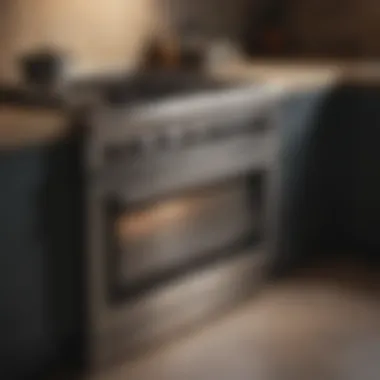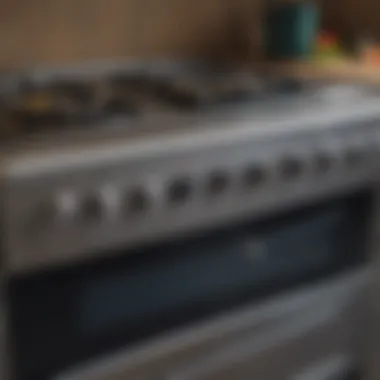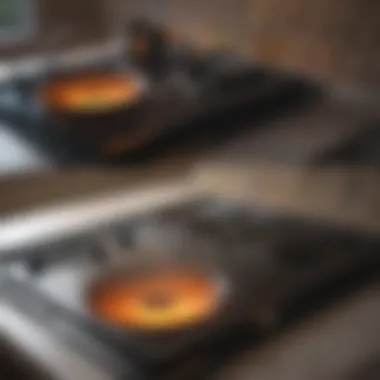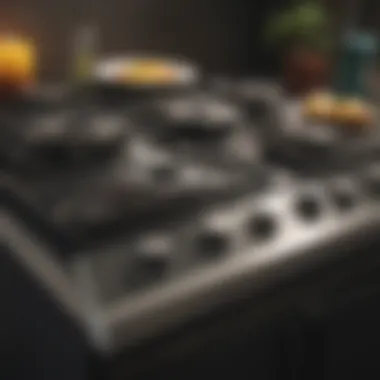A Comprehensive Guide to Cleaning a Cooker


Intro
Cleaning a cooker is more than just a superficial task; it plays a vital role in maintaining the overall hygiene and effectiveness of your kitchen. Many homeowners overlook this essential chore, which can lead to both unsightly mess and potential health risks. Having a clean cooker not only enhances the aesthetics of your cooking space but also ensures safety and efficiency in food preparation.
In this guide, we will delve into various methods of cleaning gas, electric, and induction cookers. Every type of cooker has its own characteristics and cleaning requirements, making it crucial to adopt the right approach for each. We will discuss recommended cleaning agents, necessary tools, and safety precautions. Practical tips aim to help you not only clean efficiently but also maintain your cooker effectively. The importance of hygiene in the kitchen cannot be overstated, and with the proper knowledge, you can achieve a spotless and functional cooking area.
Let us explore the key insights related to cooker maintenance that every discerning homeowner should know.
Prelims to Cooker Cleaning
Cleaning a cooker is not just a chore; it is essential for effective kitchen management. A clean cooker helps maintain hygiene, promotes safety, and enhances the cooking experience. The buildup of grease, food particles, and carbon can lead to not only unpleasant odors but also health risks for those who prepare meals. Furthermore, regular cleaning can extend the lifespan of the cooker, ensuring it operates efficiently for a long time. It is imperative to understand the various cleaning methods, the materials of different types of cookers, and specific considerations necessary for an effective cleaning process.
Importance of a Clean Cooker
A clean cooker plays a vital role in household hygiene. It prevents the growth of bacteria and ensures safe food preparation. Additionally, a well-maintained cooker is more efficient, saving energy and reducing cooking time. Many may overlook the visible aspects of the cooker’s cleanliness, but hidden corners and components require equal attention. Regular cleaning also preserves the aesthetic appeal of the kitchen, contributing to an overall pleasant environment.
Types of Cookers and Their Materials
Understanding the different types of cookers is crucial for selecting appropriate cleaning methods. Each type has various materials and components that respond differently to cleaning techniques and agents.
Gas Cookers
Gas cookers are favorited for their speed and control over cooking temperatures. They often feature burner grates made of cast iron or stainless steel which are extremely durable. These materials can withstand high heat, making them ideal for cooking.
Advantage: Quick heat adjustment that many cooks appreciate.
Disadvantage: The need for more frequent cleaning due to visible grease and food debris.
Gas cookers usually have a removable design which allows for easy access to clean burners, although some older models might present more of a challenge.
Electric Cookers
Electric cookers are widespread due to their convenience. These cookers often come with a smooth glass top that is easy to clean. The even heat distribution ensures that cooking is consistent.
Advantage: They can be easier to maintain and clean compared to other types.
Disadvantage: Spills can sometimes burn onto the surface if not cleaned immediately, making later cleaning more difficult.
It's important to use the right cleaning substances that won't scratch the glass surface, ensuring a long-lasting shine.
Induction Cookers
Induction cookers use electromagnetic fields to heat pots and pans directly rather than the surface. This feature helps in easy cleaning since the surface itself remains cooler, limiting burnt food residues.
Advantage: Generally easier to clean due to minimal food traps.
Disadvantage: Special cookware is needed, which may add an extra layer of consideration for users.
Induction cookers require regular maintenance, particularly of the glass surface, to keep it looking pristine.
By understanding the variations in cooker types, readers can adopt tailored cleaning methods that will be most effective for their specific models.
Preparing for the Cleaning Process
Cleaning a cooker is not a mundane task; it is a process that demands some preparation. Organizing for the cleaning session is crucial for efficacy and efficiency. A well-prepared environment allows one to focus on the task and minimizes frustration. Preparing entails gathering supplies, understanding safety measures, and having a clear plan. By being ready, you save time and ensure that the cleaning is thorough.
Gathering Necessary Supplies


Cleaning Agents
The choice of cleaning agents plays a vital role in achieving desirable results during the cleaning process. Different types of cleaners serve distinct purposes, so selecting the right one is essential. Common cleaning agents include all-purpose cleaners, baking soda, vinegar, and specialized oven cleaners. Each has unique properties that make them effective.
For instance, baking soda is known for its natural abrasiveness and deodorizing qualities. This characteristic makes it a safe and popular choice for many homeowners. On the other hand, commercial oven cleaners may contain strong chemicals designed to cut through tough grease and stains. However, caution is needed because they can be harsh on certain materials and emit strong fumes.
"Choosing the right cleaning agent is half the battle in maintaining a clean kitchen."
A balance between effectiveness and safety should guide your selection. While some agents are powerful, they may damage surfaces if used improperly.
Tools and Equipment
The effectiveness of the cleaning process hinges on using the right tools and equipment. Basic tools like sponges, scrub brushes, and microfiber cloths are staples. They help reach tight corners and crevices, ensuring a thorough clean.
Additionally, specialized tools like steam cleaners can be beneficial for deep cleaning, especially in hard-to-reach areas. For serious cleaning tasks, a putty knife can assist in scraping away stubborn residues. Having tools that suit your specific needs will enhance the cleaning efficiency.
However, it is worth noting that some tools can potentially scratch or damage surfaces if not handled correctly. Thus, it's crucial to choose tools appropriate for the cooker material being cleaned.
Safety Precautions to Consider
Disconnecting Power Sources
Taking the step to disconnect power sources before beginning the cleaning process is more than just a precaution; it is a necessity. Whether dealing with gas or electric cookers, ensuring that all power inputs are removed eliminates the risk of unintended ignition or electrical shock. This action greatly enhances safety, making it easier to clean without worrying about accidental activation.
The unique advantage of disconnecting power sources lies in its simplicity. It does not require specialized knowledge, but it significantly reduces risk factors. Ignoring this step can lead to hazardous situations, so it is crucial not to overlook it when preparing for cleaning.
Wearing Protective Gear
Finally, wearing protective gear is an essential aspect of the cleaning process. Gloves, goggles, and masks may seem trivial, but they provide necessary protection against harsh chemicals and debris. Gloves serve as a barrier against irritants present in many cleaning agents, while goggles protect eyes from splashes.
Masks can be particularly useful when using strong chemical cleaners, as they prevent inhalation of harmful fumes. Although wearing protective gear may add a minute to your preparation, the safety provided is invaluable.
In summary, being careful about safety and preparing for cleaning can save a lot of trouble down the road. A detailed plan will enhance not only cleanliness but also safety in the kitchen.
Step-by-Step Guide to Cleaning a Gas Cooker
Cleaning a gas cooker is crucial for numerous reasons. First, a clean cooker directly impacts food safety. Residue from previous cooking sessions can encourage bacterial growth, leading to potential health risks. Furthermore, a well-maintained gas cooker functions effectively, which enhances cooking efficiency and reduces gas wastage. Regular cleaning not only preserves the appliance's aesthetic appeal but also prolongs its lifespan, making it a vital part of kitchen maintenance.
Cleaning the Burners and Grates
Start by ensuring that the cooker is off and cool to touch. Detach the grates and burners from the cooker. Soaking these pieces in warm, soapy water can be effective in loosening any stubborn grime. For tougher stains, a mixture of baking soda and vinegar can be applied to the grates. Let it sit for around 15 minutes before scrubbing. This method assists in breaking down grease and burnt food particles. Use a soft-bristle brush or a sponge to scrub the surfaces gently, avoiding any abrasive materials that might scratch them. Rinse thoroughly and allow them to dry completely before reassembling.
Wiping Down the Surface
Clean the surface of the gas cooker with a damp cloth. You can use a mixture of dish soap and warm water for this task. Begin with a light soaping of the cloth, and then wipe down all accessible surfaces including knobs and areas surrounding the burners. Pay special attention to any sticky or greasy spots. A thorough wipe not only removes visible dirt but can also eliminate allergens or residues that might get transferred to food. A final wipe down with a dry cloth can help in achieving a streak-free finish.
Cleaning the Oven Section
When it comes to the oven section, the cleaning approach may differ slightly depending on the type of oven in the gas cooker. If the oven has a self-cleaning feature, follow the manufacturer's guidelines for its use. If not, you may need to employ a solution of baking soda mixed with water to form a paste. Spread the paste inside the oven and let it sit for several hours or overnight if the stains are particularly tough. Afterward, wipe out the paste with a damp cloth, and use a plastic scraper for any remaining residue. For burnt-on food, a natural method is to heat a pan of water with vinegar inside the oven, which produces steam that loosens grime.
"Regular maintenance of your gas cooker can save you time and money in the long run."


Step-by-Step Guide to Cleaning an Electric Cooker
Cleaning an electric cooker is crucial for maintaining not only hygiene but also the efficiency of your cooking appliance. An electric cooker undergoes heavy use and can accumulate food residues, grease, and stains over time. Regular cleaning not only enhances the overall look of your kitchen but also extends the lifespan of the cooker. In this section, we will detail step-by-step instructions to effectively clean an electric cooker, focusing on the cooktop, control panel, and oven.
Removing and Cleaning the Cooktop
The cooktop is the most visible part of an electric cooker and tends to attract the most grime. Keeping it clean is important for aesthetics and functionality. To clean the cooktop:
- Turn Off the Cooker: Ensure all controls are off before commencing.
- Gather Supplies: You will need a soft cloth, sponge, and a non-abrasive cleaner suitable for your cooktop material.
- Wipe Down the Surface: Use a damp cloth to remove loose debris. This step prepares the surface for deeper cleaning.
- Use Cleaner: Apply a small amount of cleaner directly to the cooktop. Use a non-abrasive sponge to gently scrub the surface. For tough spots, let the cleaner sit for a short while before scrubbing.
- Rinse and Dry: After scrubbing, wipe the surface thoroughly with a damp cloth to remove cleaner residue. Finally, dry with a soft towel to prevent streaks.
This process ensures a clean and shiny cooktop, contributing to a more pleasant cooking experience.
Cleaning the Control Panel
The control panel of an electric cooker often collects grease and fingerprints. Regular cleaning is essential for maintaining functionality and cleanliness. Follow these steps:
- Turn Off Power: Safety is paramount; ensure the cooker is off to prevent any electrical issues.
- Choose the Right Tools: Use a microfiber cloth and a gentle cleaner or vinegar solution to avoid damage.
- Wipe the Panel: Dip the cloth in the cleaning solution, wring it out, and gently wipe the control panel. Be careful around buttons and knobs, as excess moisture can harm the electrical components.
- Dry Immediately: Use a dry cloth to wipe down the panel after cleaning. This prevents the buildup of moisture.
- Avoid Harsh Chemicals: Never use abrasive cleaners or scrubbing pads, as these can scratch the surface.
With a little attention, the control panel can remain functional and visually appealing.
Dealing with Oven Residue
Cleaning the oven section of an electric cooker is a task that requires attention to detail and proper technique. Residues can become tough over time, making it imperative to approach this cleaning methodically. Here’s how:
- Remove Trays and Racks: Start by taking out any trays and racks inside the oven. This allows you to clean the entire space without obstruction.
- Prepare Cleaning Solution: Mix baking soda with water to create a paste. This natural cleaner is effective and safe for oven surfaces.
- Apply and Leave: Spread the paste on any stained areas inside the oven. Leave it for several hours or overnight for the best results.
- Scrub and Wipe: After the dwell time, use a damp cloth or sponge to wipe away the paste and stains. For baked-on residues, a non-scratch scrubber can help.
- Final Rinse: Wipe all surfaces with a clean, damp cloth to ensure no residues remain. Dry thoroughly before replacing trays and racks.
This careful approach to cleaning the oven will yield a fresher cooking environment and improve cooking performance.
Step-by-Step Guide to Cleaning an Induction Cooker
Cleaning an induction cooker is pivotal for ensuring not just the device’s operational efficiency but also its aesthetic appeal. The unique surfaces and components of an induction cooker can require specific care which, if overlooked, may lead to performance issues or lasting damage. Understanding the nuances of cleaning induction cookers can result in a longer lifespan for the appliance and better cooking results.
Cleaning the Glass Top
The glass top of an induction cooker is both stylish and practical. It provides a flat surface that allows for easy cleaning but can show smudges and food residue quite readily. When cleaning the glass surface, it is important to use the right materials.
- Gather a Non-Abrasive Cleaner: Use a cleaner designed specifically for glass tops. Avoid harsh chemicals that can damage the surface.
- Soft Cleaning Cloths: Use microfibre cloths for wiping down the surface as these are less likely to scratch.
- Allow the Surface to Cool: Before starting, ensure the cooktop has completely cooled to avoid burns.
- Apply Cleaner: Spray the non-abrasive cleaner evenly across the glass surface.
- Wipe Gently: Use the microfibre cloth to wipe away debris and grease in a circular motion. This will help lift any stubborn dirt.
- Rinse and Dry: After cleaning, you might want to wipe the surface with a clean damp cloth to remove any cleaning residue, then dry it with another clean cloth for a streak-free finish.
Regular cleaning of the glass top not only keeps it looking presentable but also enhances its functionality, ensuring that heat is evenly distributed.
Regular Maintenance of Induction Elements
The heating elements of an induction cooker function using electromagnetic energy, generating heat only when cookware is placed on them. Therefore, keeping these elements clean is paramount for optimal performance. Here are some maintenance tips:
- Wipe After Each Use: After cooking, take a moment to wipe the induction elements once they cool down. This helps prevent the buildup of food particles.
- Inspect Cookware: Using suitable magnetic cookware is crucial. Avoid warped or damaged pots as these can damage the induction surface and decrease efficiency.
- Consistent Deep Cleaning: Periodically, check beneath the cooktop. Dust and grime can accumulate under the surface, affecting functioning. A vacuum cleaner with a soft brush attachment can be used carefully for this.
By employing these practices, you maintain both the performance and longevity of your induction cooker. Regular maintenance ensures that you can cook with confidence, knowing that your appliance will perform at its best next time you enter the kitchen.
"A clean environment leads to better cooking experiences and enhances overall safety in the kitchen."


Advanced Cleaning Techniques
In the realm of cooker maintenance, advanced cleaning techniques play a pivotal role. These methods allow for a deeper and more efficient cleaning process that can tackle stubborn stains and odorous residues. Utilizing these techniques not only enhances the appearance of your cooker but also improves its functionality and longevity. By understanding these advanced methods, homeowners can save time and effort while maintaining the essential hygiene standards in their kitchen.
Using Steam Cleaners
Steam cleaning has emerged as a highly effective advanced cleaning method for cookers. This technique leverages the power of steam to penetrate grime and grease without the use of harsh chemicals. The high temperature of the steam loosens dirt, which makes it easier to wipe away.
- Efficient Cleaning: Steam cleaners can sanitize surfaces, making them an excellent choice for cooking appliances.
- Eco-Friendliness: Since this method relies primarily on water, it minimizes chemical usage, appealing to eco-conscious homeowners.
- Versatility: Steam cleaners can often be used on various surfaces, including stainless steel and ceramic, which are common in cookers.
However, users should adhere to manufacturer guidelines, ensuring the steam cleaner is compatible with their specific cooker type to avoid damage.
Removing Tough Stains and Odors
Tough stains on a cooker can be quite challenging to remove, especially if they have been allowed to set for a long time. The following steps can assist in effectively tackling these persistent problems:
- Identify the Stain: Knowing what caused the stain helps in choosing the right cleaning agent.
- Use Baking Soda: This common household item can be used to create a paste with water. Apply it directly onto the stain and let it sit for a while before scrubbing.
- Vinegar and Water Solution: A mixture of vinegar and water can also help neutralize odors while cleaning.
"Regular maintenance and prompt cleaning of spills can greatly reduce the effort needed for advanced cleaning techniques."
By focusing on these strategies, one can significantly enhance their cooker’s performance while maintaining an aesthetically pleasing kitchen environment. Regular attention to these advanced techniques will keep your cooking space clean and welcoming.
Preventative Measures for Cooker Maintenance
Maintaining a cooking appliance goes beyond just cleaning it regularly. Preventative measures are vital to ensure both the longevity and efficiency of your cooker. A proactive approach can save you time, money, and effort over the long term, making your cooking experience smoother and more pleasant. By adopting a regular cleaning schedule and using cookware appropriately, you can avoid excessive grime and damage.Regular maintenance not only keeps your cooker looking its best, but it also helps to reduce the risk of potential fire hazards and ensures optimal performance. Moreover, it fosters a hygienic cooking environment, essential for health-conscious individuals and families.
Regular Cleaning Schedule
Establishing a regular cleaning schedule is crucial for maintaining a cooker. The frequency of cleaning can depend largely on how often you use your cooker.
- Daily: Wipe down surfaces after each use. This includes the stovetop, oven door, and knobs.
- Weekly: Deep clean any removable parts, such as grates and burners. For electric and induction cookers, ensure that the cooktop is cleaned thoroughly weekly too.
- Monthly: Conduct a more comprehensive cleaning of the oven, especially if you've been cooking greasy or baked items.
- Seasonal: Inspect for any wear and tear in the structure and components of the cooker, particularly for older models.
A well-defined cleaning schedule can prevent the buildup of stubborn stains, grease, and food scraps, which can be hard to remove if neglected.
Proper Use of Cookware
Using the right cookware is equally essential in maintaining your cooker. The type of cookware can significantly affect your cooking surface and overall performance.
- Material matters: Use pots and pans made of the right materials, such as stainless steel or cast iron for gas and electric cookers. Induction cookers require ferrous materials for optimal operation.
- Size considerations: Ensure that your pots are not too large or too small for the burners. Oversized pots can lead to spills that might damage your cooker.
- Avoid scratching: Be careful with utensils to avoid scratching the surface of your cooktop. Soft wooden or silicone utensils are recommended.
By taking these simple measures, you can maintain a cooker that not only functions efficiently but also enhances your overall cooking experience.
"A clean and well-maintained cooker is an integral part of a well-run kitchen."
End
In this article, we have highlighted the significance of maintaining a clean cooker. Regular cleaning not only enhances the aesthetic appeal of the kitchen but also promotes hygiene and prolongs the life of the appliance. By keeping your cooker clean, you reduce the risk of bacterial contamination, enhance cooking efficiency, and improve the flavor of the food prepared.
Furthermore, this guide provides a structured approach to cleaning different types of cookers—gas, electric, and induction. Each type requires specific techniques and considerations, as described throughout the article. Understanding these differences is key to maintaining your kitchen's functionality.
Continuing to follow the preventive measures suggested can greatly simplify the cleaning process. Regular maintenance offers several benefits:
- It minimizes the buildup of grime.
- It ensures that all components function optimally.
- It saves time in the long run by avoiding deep clean emergencies.
Remember, investing time in cooker cleaning translates to better cooking experiences and a more pleasant kitchen environment. Thus, embracing a meticulous cleaning routine is beneficial in so many aspects.
Summary of Key Points
- A clean cooker enhances kitchen hygiene and aesthetics.
- Different cookers require tailored cleaning methods.
- Preventive maintenance reduces cleaning times and extends cooker life.
- Regular cleaning is critical for safe and efficient cooking.



